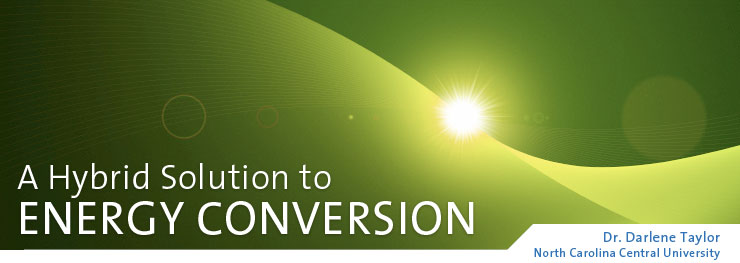


|
Novel Poly(p-phenylene)-based Hybrid Materials for |
Developing new technologies that take advantage of the abundant energy from the sun is key to stimulating the economy, protecting our national security, and ensuring a sustainable way of life. "There's a huge push to look for alternative sources of energy that are not fossil fuel-based, and solar cells fit that bill," says Darlene Taylor, assistant chemistry professor at North Carolina Central University. Since 2005, Taylor has been developing technology that could help solar cells become a viable source of renewable energy on a much larger scale. Right now, cumulative solar energy production accounts for less than 0.01% of the total global energy demand.

Professor Taylor's students in the lab
Solar cells convert sunlight into electrical charges, mimicking the naturally occurring process of photosynthesis. Ninety-four percent of the products in the current marketplace are made with inorganic crystals. The drawbacks associated with these materials are that they are expensive to manufacture and ultimately inefficient. Taylor, along with other scientists, increasingly feels that the answer lies in organic, polymer-based solar cells. These cells are lighter, more flexible, and less expensive to produce than inorganic cells. "I set out to look at this class of polymers in particular, called poly(p-phenylenes), or PPPs," she states. While significant research had already been done with PPPs, Taylor decided to investigate the idea of a hybrid version. Her project examines how different variations of the poly paraphenylenes, joining with an inorganic material like a semiconductor nanostructure, can lead to significant improvements in energy conversion. "Combining the best properties of all these," she says, "has not been widely explored."
The possibilities for her findings are astounding. According to Taylor, "if these materials are at all successful then there's potential that they could be commercially licensed—I wouldn't put that outside my reach." The possibilities are even more impressive given the fact that Professor Taylor is leading this research effort at a small university with an ever-changing team of undergraduate students. She felt that this type of project was perfect for an undergraduate team. She had a compelling story - converting sunlight to electricity - that would entice kids to join her, and no need for high-tech, expensive instruments. In fact, it is the chance to mentor and positively influence her students that excites her the most. As someone who was deeply affected by a college chemistry teacher, Taylor hopes that she, too, can inspire a few of her interns to go on to pursue chemistry at the graduate level. "Of the ones that I have had an opportunity to work with," she says, "I can definitely say some light bulbs have gone off."
Read more about Dr. Taylor's research on Design and Systhesis of Core-Shell OptoElectronic Nanoparticles Based on Oligo(p-phenylene)s.

One of Professor Taylor's students, working with a solution calorimeter